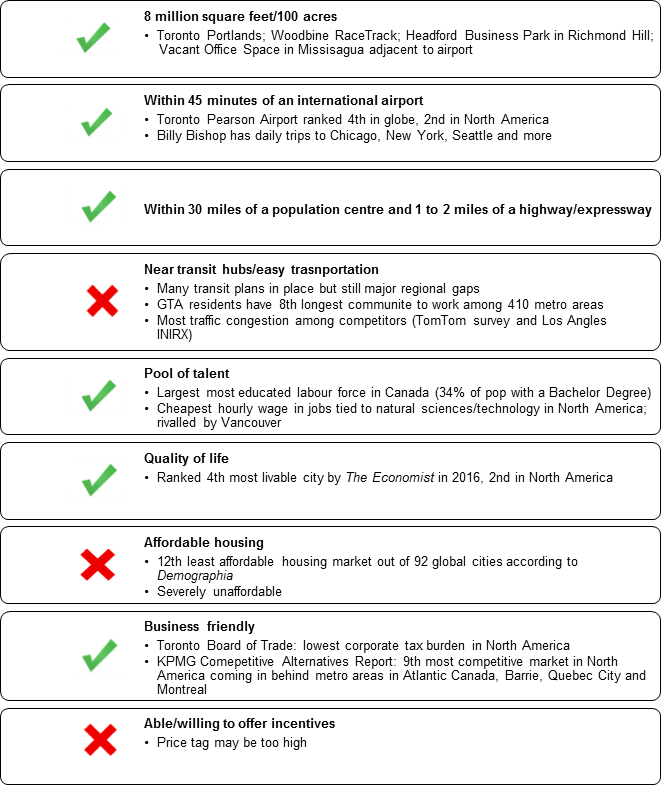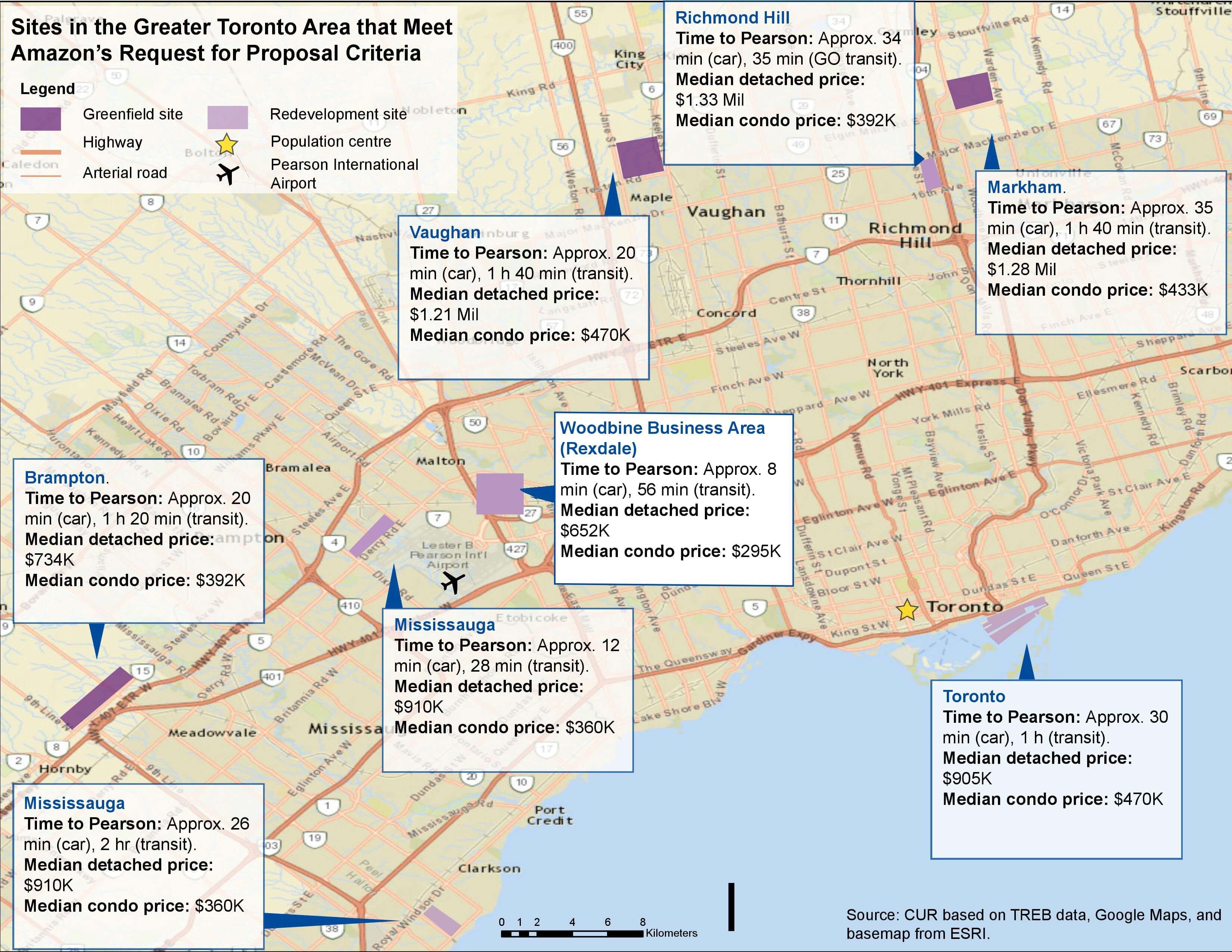What can the GTA do to attract Amazon?
By: Diana Petramala with research assistance provided by Jodee Ng
October 4, 2017
Amazon is looking for a home for its second North American headquarters (HQ2), and it has called on all major metropolitan areas to bring them their best offer. Over 100 cities will be bidding to win over the tech giant, the Greater Toronto Area (GTA) included.
So what will it take to win Amazon?
Amazon has laid out a set of criteria for what it is looking for in its next home (Figure 1). Most importantly, Amazon is looking for a creative proposal to develop an eventual 8 million square foot facility to house 50,000 employees, with close proximity to an urban centre, transportation, a large pool of talent and affordable housing.
Bets on who would win the bid have been rolling in ever since Amazon made its announcement on September 9th. Figure 1 highlights why the GTA is a favourite. U.S. analysts have been talking up the Greater Toronto Area’s game by highlighting its large talent pool, ease of attracting foreign talent through more favourable immigration policies relative to its U.S. counterparts and a fairly low cost of doing business. While the region will face tough competition from some U.S. regions, the GTA seems to be the best Canadian option for HQ2.
But the bid won’t come without its challenges. Chief among them is political uncertainty south of the border, including uncertainty over the renegotiation of the North American Free Trade Agreement and the Trump administration’s keen desire to keep U.S. companies from expanding outside of the country. Other challenges include affordable housing, transportation concerns and the need to offer up substantial monetary incentives.
Figure 1: GTA's checklist in its bid for Amazon

How can a proposal overcome these challenges?
The GTA task force should be thinking big – big incentives that is. New York State just gave Amazon $20 million in tax incentives to build an office to employ 2,000 employees. HQ2 is 25 times larger. Extrapolating from the scale of the New York project suggests a bare minimum of $500 million would be needed to win HQ2. And we suspect that other U.S. cities and regions will be equally as generous. Why? Because they know that the payoff will be worth it. A 2013 (PDF file) study (external link) by Enrico Moretti and Per Thulin from the University of Berkley found that the highly productive/high paying jobs Amazon proposes to create would have significant positive knock-on effects to domestic businesses through what economists call the multiplier effect. Amazon will spend money on supplies and amazon employees will spend money on consumer goods and services. According to Moretti’s and Thulin’s research, the 50,000 jobs Amazon expects to create directly could actually lead to an additional 250,000 jobs through some of the additional positive impacts on the winning region’s economy. Technology firms have the biggest positive knock-on effects than businesses from any other industry.
The GTA’S proposal should also offer creative solutions to the region’s affordable housing concerns. A bid to win Amazon should not only offer a solution to find space for its employees, but also to help to significantly improve the region’s sluggish responsiveness of housing supply to increases in demand, especially ground-related housing forms. There are pockets of affordable housing near some of the locations of where HQ2 would fit (Figure 2). However, the same 2013 study by Moretti and Thulin found that winning the headquarters of a major technology firm would also put upward pressure on home prices, by increasing demand for housing. However, if housing supply responds quickly to demand, then the additional gains in household incomes will more than offset an increase in home prices. But, if supply is less responsive, then the rise in home prices could offset the rise in household incomes. An Amazon win could escalate the Greater Toronto Area’s affordability concerns absent of a plan to target housing supply in a big way for ground-related housing.
Lastly, the region needs to address regional transportation gaps. The city has made considerable headwinds in developing new transportation hubs with the UP express to the airport, the subway extension to York University, opening in December of this year, and the Eglington cross town, opening in 2021. The City of Toronto also has some of the world’s most walkable and transit friendly (measured by number of services routes per kilometer) neighbourhoods in the world.
The issue is that the land available for Amazon is not near any of these transportation hubs and there are still significant regional gaps in transportation to connect the five municipalities. There is a proposal to build a transportation hub in the airport, which could be kick started by Amazon’s bid. This hub would connect the airport corporate center to the downtown core.
In the interim, the region can offer temporary solutions to moving Amazon’s employees around the region, including adding local and GO bus routes. But heavy congestion is still going to make it difficult to get around, especially during peak hours. The race for Amazon’s HQ2 raises the importance of continuing to develop transportation hubs where the region still has space for both residential and non-residential development.
The hard work will be worth it
This is an opportunity the region should not miss out on. The GTA is in need of productivity boosting (non-housing) stimulus. While the region continues to develop jobs, labour productivity and household income growth has not kept up. The GTA had the weakest performance in output per worker among most major North American Urban Regional economies between 2003 and 2013, despite the U.S. having gone through a financial crisis. Amazon is also the world’s leader in research and development spending. Taking advantage of that investment may also be the key to helping improve the region’s productivity conundrum.
Figure 2: Potential Sites in the GTA for Amazon's HQ2

___________________________________________________________________________________________________________
Diana Petramala is Senior Researcher at the Centre for Urban Research and Land Development (CUR) at Toronto Metropolitan University